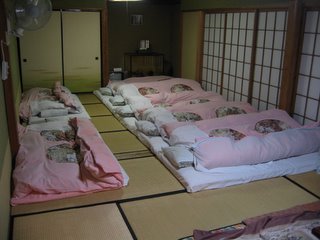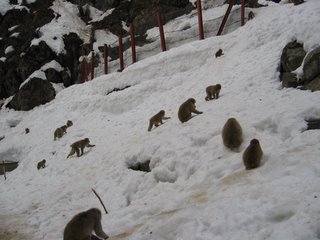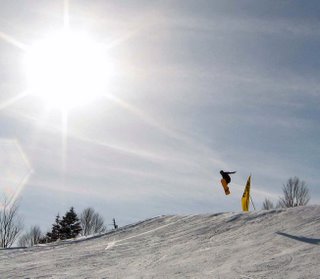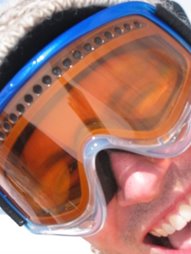 A small dog chained within range of soiled bed sheets greeted us as we made our way through the entrance of the ryokan. We were too tired from a day of snowboarding to let the familiar yet disturbing smell of ammonia deter us from our immediate goals: sit in hot water, dress, eat. We dropped our bags in a 16 tatami mat room that had been outfitted with seven sets of bedding (the scene eliciting in us those faded, fuzzy, stubborn memories of sleep-away camps and after-lights-out conversations that trick us into dreading aging and missing the unsalvageable ghost wreckage of time), changed into cloth robes called yukatas, and forced our sore muscles to carry us over to the onsen. The worn wood that lined the onsen tub, wood so weathered it looked as if it had deflected the slow ripples of onsen water for centuries, felt soft and smooth on the skin of my neck.
A small dog chained within range of soiled bed sheets greeted us as we made our way through the entrance of the ryokan. We were too tired from a day of snowboarding to let the familiar yet disturbing smell of ammonia deter us from our immediate goals: sit in hot water, dress, eat. We dropped our bags in a 16 tatami mat room that had been outfitted with seven sets of bedding (the scene eliciting in us those faded, fuzzy, stubborn memories of sleep-away camps and after-lights-out conversations that trick us into dreading aging and missing the unsalvageable ghost wreckage of time), changed into cloth robes called yukatas, and forced our sore muscles to carry us over to the onsen. The worn wood that lined the onsen tub, wood so weathered it looked as if it had deflected the slow ripples of onsen water for centuries, felt soft and smooth on the skin of my neck. We shattered a conversation when we walked into a small family-owned ramen shop that doubles as a living room. The sitting family quickly bustled about to make us feel comfortable and showered us with politeness. We took our seats around a kitchen table that encircled a kerosene heater. A commercial-laden Olympic broadcast was droning on in the background on a TV set in the corner. Above the TV, a perfectly spherical wasp nest watched over the room from within a beautiful glass cube like some sort of natural security camera. The food was excellent and the owners bid us adieu with a bag of seven large apples.
We shattered a conversation when we walked into a small family-owned ramen shop that doubles as a living room. The sitting family quickly bustled about to make us feel comfortable and showered us with politeness. We took our seats around a kitchen table that encircled a kerosene heater. A commercial-laden Olympic broadcast was droning on in the background on a TV set in the corner. Above the TV, a perfectly spherical wasp nest watched over the room from within a beautiful glass cube like some sort of natural security camera. The food was excellent and the owners bid us adieu with a bag of seven large apples. I awoke the following morning excited for the day’s main activity: we were going to see a type of macaque found nowhere else in the world (I’m told), a monkey with a red face and an affinity for lounging in hot springs. We packed the cars, drove and parked, and walked 30 minutes up into the mountains to reach the Monkey Park, a place marked and advertised by numerous signs and pictures of cartoon monkeys.
I awoke the following morning excited for the day’s main activity: we were going to see a type of macaque found nowhere else in the world (I’m told), a monkey with a red face and an affinity for lounging in hot springs. We packed the cars, drove and parked, and walked 30 minutes up into the mountains to reach the Monkey Park, a place marked and advertised by numerous signs and pictures of cartoon monkeys.After passing an alarming amount of retreating foreigners on the tree-lined path up to the park (a potential warning sign that one is about to feel like or be in the company of a tourist-culture-junky with a prize-winning photo fix always just out of reach), we paid 500 yen (about $4.50) and walked around a small building that overlooked a river-split gully. What I saw before me took me by surprise: there were monkeys everywhere and they seemed to be in complete control of the surrounding landscape. No cages or chains were in sight.
 Revealing facets of their character using human mannerisms (forcing all Christians in attendance to truly question their beliefs on evolution), the monkeys were scampering up fences like convicts with the warden’s blood on their hands, lovingly and painstakingly grooming each other on boulders like mothers picking sand out of their daughters’ hair after a day at the beach before an evening dance recital, shitting on white, virgin snow like drunks unexpectedly thrust into bowel emergency after a long winter rock concert, playing in the trees in packs like five-year-olds at recess, squawking and chasing each other up the mountain like flirting adolescents with a first kiss floating in the near future like a low-lying cloud, and sitting lazily in the hot spring pools like elderly people enjoying a dip in the Jacuzzi after a doctor-recommended stroll on the treadmill.
Revealing facets of their character using human mannerisms (forcing all Christians in attendance to truly question their beliefs on evolution), the monkeys were scampering up fences like convicts with the warden’s blood on their hands, lovingly and painstakingly grooming each other on boulders like mothers picking sand out of their daughters’ hair after a day at the beach before an evening dance recital, shitting on white, virgin snow like drunks unexpectedly thrust into bowel emergency after a long winter rock concert, playing in the trees in packs like five-year-olds at recess, squawking and chasing each other up the mountain like flirting adolescents with a first kiss floating in the near future like a low-lying cloud, and sitting lazily in the hot spring pools like elderly people enjoying a dip in the Jacuzzi after a doctor-recommended stroll on the treadmill. Everything would have been serene had I not been there to witness it. That’s right, my footprints, much like the small bundles of excrement that dotted and stained the frozen white landscape like meteors sent from a distant fecal galaxy far far away, seemed to clash with their surroundings. My presence, along with that of about 20 other Monkey Park visitors, hijacked the monkey magic that floats thick in the air in gullies populated by wild monkeys and replaced it with an invisible sludge of tourist indulgence. The worlds of man and monkey don’t mesh as well as one would have expected. Monkeys ran past high heels to pick up seeds thrown—by the thousands—onto the park grounds to keep the monkeys coming back, day after day. People (myself included) snapped dozens of pictures hoping to preserve the heady reality of exoticism that incubates beautiful things like fleeting steam. A park employee put pieces of an apple into a clear plastic tube so a throng of onlookers could watch as monkeys used a small stick to reach their familiar prize. Monkeys clamored over a ‘Live Monkey Cam’ as two women stood before the camera’s glare and tried to hold five-minute-smiles and a handwritten note for a friend back home (five minutes, according to the one woman, is the amount of time one must wait to guarantee a captured image on the Monkey Cam). Just the sound of it…Monkey Cam…irks me. Traffic and Cam are two words that can be seamlessly wed: Traffic Cam. Nothing wrong. But Monkey Cam? Something about it seams ridiculous.
Everything would have been serene had I not been there to witness it. That’s right, my footprints, much like the small bundles of excrement that dotted and stained the frozen white landscape like meteors sent from a distant fecal galaxy far far away, seemed to clash with their surroundings. My presence, along with that of about 20 other Monkey Park visitors, hijacked the monkey magic that floats thick in the air in gullies populated by wild monkeys and replaced it with an invisible sludge of tourist indulgence. The worlds of man and monkey don’t mesh as well as one would have expected. Monkeys ran past high heels to pick up seeds thrown—by the thousands—onto the park grounds to keep the monkeys coming back, day after day. People (myself included) snapped dozens of pictures hoping to preserve the heady reality of exoticism that incubates beautiful things like fleeting steam. A park employee put pieces of an apple into a clear plastic tube so a throng of onlookers could watch as monkeys used a small stick to reach their familiar prize. Monkeys clamored over a ‘Live Monkey Cam’ as two women stood before the camera’s glare and tried to hold five-minute-smiles and a handwritten note for a friend back home (five minutes, according to the one woman, is the amount of time one must wait to guarantee a captured image on the Monkey Cam). Just the sound of it…Monkey Cam…irks me. Traffic and Cam are two words that can be seamlessly wed: Traffic Cam. Nothing wrong. But Monkey Cam? Something about it seams ridiculous. We stood in awe of animals that were conditioned by years of exploitation to care little about us. One-way-fascination is hard to swallow in certain situations. Sure, watching an animal while unnoticed from afar as the animal goes about its business is exciting and informative. But seeing monkeys scamper around feverishly to collect peanuts, seemingly unaware of the clicking cameras and jostling onlookers looking on, made me feel as though I was participating in a carefully contrived play, complete with pauses for audience applause.
We stood in awe of animals that were conditioned by years of exploitation to care little about us. One-way-fascination is hard to swallow in certain situations. Sure, watching an animal while unnoticed from afar as the animal goes about its business is exciting and informative. But seeing monkeys scamper around feverishly to collect peanuts, seemingly unaware of the clicking cameras and jostling onlookers looking on, made me feel as though I was participating in a carefully contrived play, complete with pauses for audience applause.National Geographic’s appeal often lies in the intensity with which animals and humans stare back at readers, seemingly stuck in a coma of interest and puzzlement and engaged in a silent, captivating dialogue with the photographer. The joy in owning a dog comes from figuring out the ways to get it to wag its tail. Would anyone love an animal that seemed parasitic in nature and was completely unalarmed by and indifferent toward other creatures in its environment? The monkeys, although technically ‘wild,’ seemed very domesticated and could care less about the people around them. I couldn’t help but feel like my admission fee had helped buy the handfuls of peanuts that the employee was scattering to keep the monkeys eating peanuts to keep people coming to make more money and buy more peanuts to keep the monkeys eating peanuts to keep the people coming to make more money and buy more peanuts to keep the monkeys eating peanuts…
 Is it wrong when environmental tourism exploits animals and their environments so that the managers of the tourist operation can survive? I don’t know, to answer the question would be to put more value on one type of life compared to another, to say a human life is more important than the life of an animal. Wildlife reserves in developing countries, however, allow indigenous people to survive. It seems safe to say that, unless it’s a matter of human survival, unless there is no other way for a family or group of people to survive and earn a living, any type of animal exploitation is unjustified.
Is it wrong when environmental tourism exploits animals and their environments so that the managers of the tourist operation can survive? I don’t know, to answer the question would be to put more value on one type of life compared to another, to say a human life is more important than the life of an animal. Wildlife reserves in developing countries, however, allow indigenous people to survive. It seems safe to say that, unless it’s a matter of human survival, unless there is no other way for a family or group of people to survive and earn a living, any type of animal exploitation is unjustified. Seeing the monkeys was fascinating. Seeing them forces one’s mind to wander into the coffers of one’s personal historical perspective, into the ‘Beliefs’ wing of one’s cognitive library. Did I leave the park cloaked in awe and feeling little and shrunken down to size just as I’ve felt after seeing other types of wildlife in their natural habitats? No. Instead I felt hungry and felt human and felt absent of that powerful buzz that comes from being overwhelmed by natural purity. I would have loved to have stumbled upon the monkey gully nestled up in the mountains 100 years ago. I don’t think, however, I would have enjoyed sticking around to watch the aftermath of discovery that seems to inevitably give birth to admission fees and peanut-throwing park employees.
Seeing the monkeys was fascinating. Seeing them forces one’s mind to wander into the coffers of one’s personal historical perspective, into the ‘Beliefs’ wing of one’s cognitive library. Did I leave the park cloaked in awe and feeling little and shrunken down to size just as I’ve felt after seeing other types of wildlife in their natural habitats? No. Instead I felt hungry and felt human and felt absent of that powerful buzz that comes from being overwhelmed by natural purity. I would have loved to have stumbled upon the monkey gully nestled up in the mountains 100 years ago. I don’t think, however, I would have enjoyed sticking around to watch the aftermath of discovery that seems to inevitably give birth to admission fees and peanut-throwing park employees. left: Me on the box in the park
left: Me on the box in the park left: Col flying higher than she's ever flown before! It's hard to tell from this pic, but she has already cleared the gap and is actually on her way down here. I could not believe my eyes when I saw her flying through the air like this. I held the camera out and snapped two photos hoping that at least one would come out.
left: Col flying higher than she's ever flown before! It's hard to tell from this pic, but she has already cleared the gap and is actually on her way down here. I could not believe my eyes when I saw her flying through the air like this. I held the camera out and snapped two photos hoping that at least one would come out. left: Me on the frighteningly long rail
left: Me on the frighteningly long rail left: Kid's table at the ryokan
left: Kid's table at the ryokan


No comments:
Post a Comment